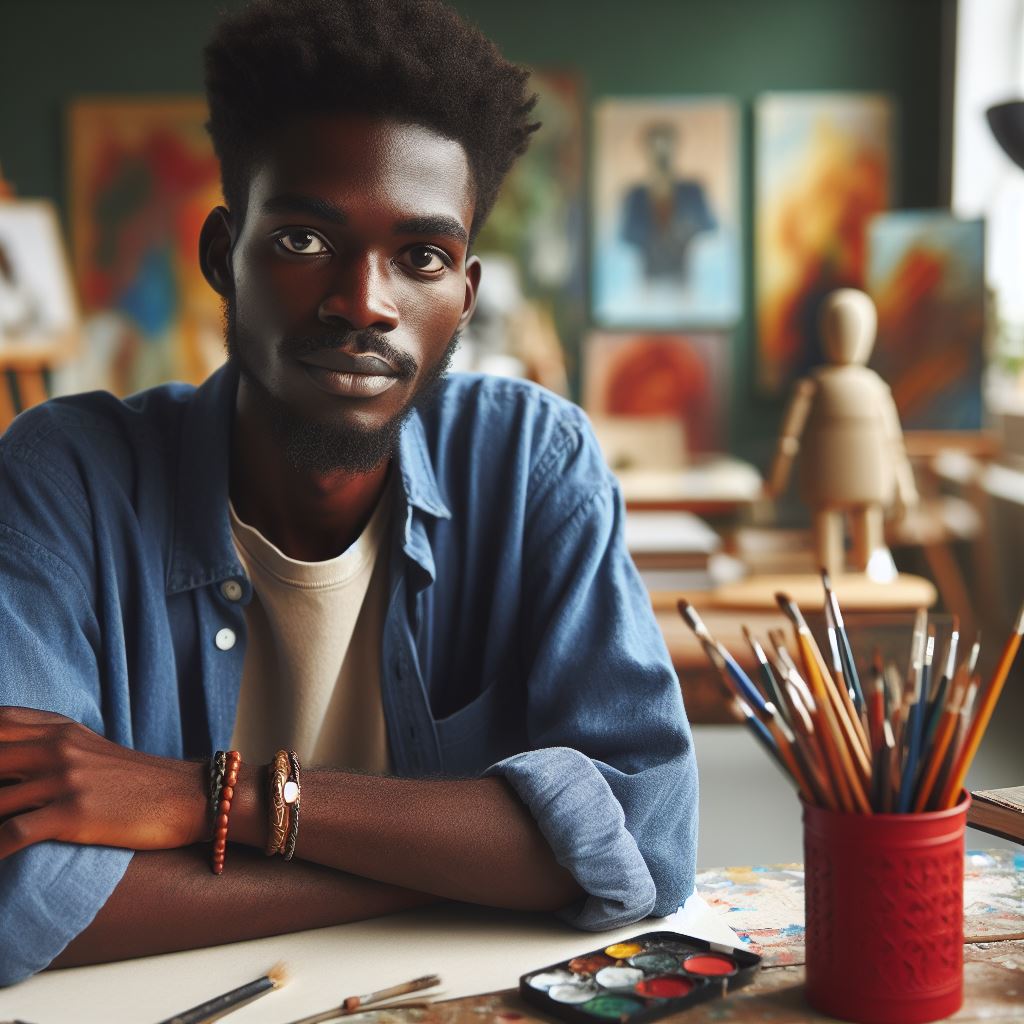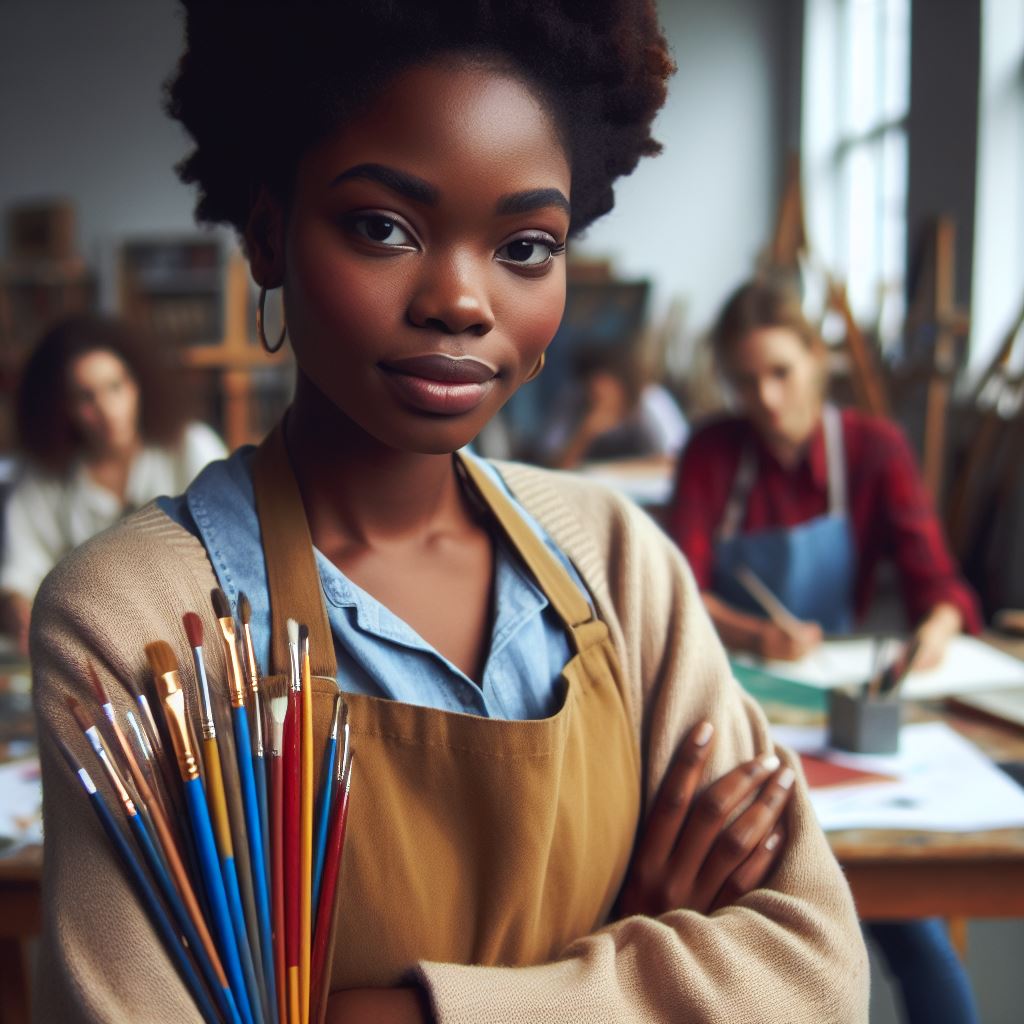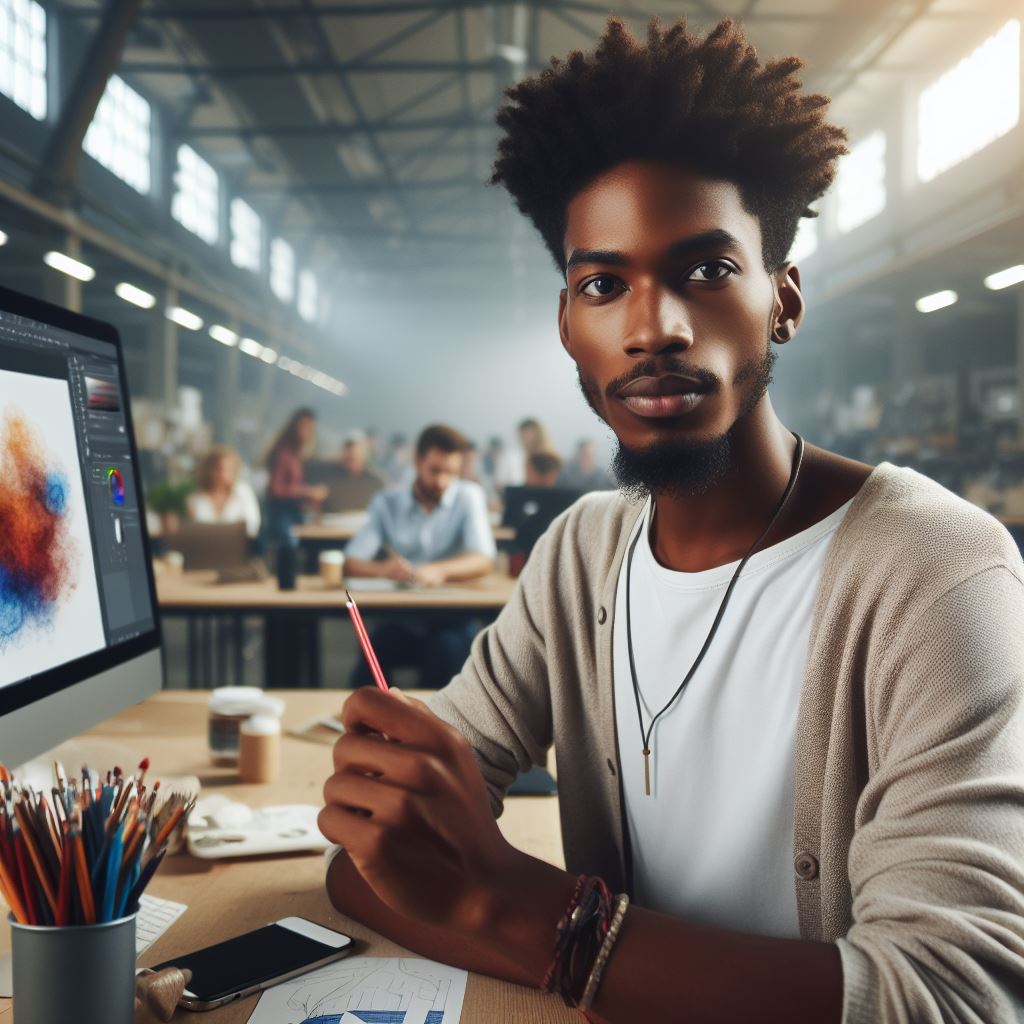Introduction
Nigerian art has had a profound impact on global culture, influencing artists and art enthusiasts worldwide.
Nigerian art dates back centuries, encompassing a rich blend of traditional practices and contemporary influences.
Legendary artists like Ben Enwonwu and Yusuf Grillo have captivated audiences with their powerful, expressive works.
Modern artists such as Njideka Akunyili Crosby are reshaping the art world with their innovative approaches.
Through exhibitions, collaborations, and awards, these artists have brought Nigerian art to the forefront of global conversations.
Brief Overview of the History and Evolution of Nigerian Art
Early Beginnings
Nigerian art boasts a rich history that spans thousands of years. Early Nigerian art includes the Nok culture, famous for terracotta sculptures. These sculptures date back to 500 BC and are renowned for their intricate details.
The Ife and Benin cultures also played significant roles in early Nigerian art. Ife’s naturalistic bronze and terracotta heads highlight their advanced sculptural techniques.
The Benin Empire’s brass plaques and statues depict regal and historical scenes, showcasing their craftsmanship.
Colonial and Post-Colonial Influences
Colonialism had a profound impact on Nigerian art. During British rule, Nigerian artists adapted to new influences while preserving their heritage.
The establishment of art schools, such as the Nigerian College of Arts, Science, and Technology, fostered a blend of traditional and contemporary styles. Post-colonial Nigeria saw a resurgence of interest in indigenous art forms.
Artists began to incorporate traditional themes into modern mediums.
Prominent Nigerian Artists and Their Impact
Ben Enwonwu
Ben Enwonwu, a pioneer of modern African art, merged traditional themes with contemporary techniques. His famous work, “Tutu,” dubbed the “African Mona Lisa,” gained international acclaim. Enwonwu’s work bridged cultural gaps and highlighted African identity on a global scale.
Bruce Onobrakpeya
Bruce Onobrakpeya, a master printmaker and sculptor, is known for his innovative techniques. He developed “plastocast relief” and “bronzed lino relief” methods.
Onobrakpeya’s art, rooted in Urhobo culture, gained recognition worldwide. His exhibitions have been held in major cities like London, New York, and Tokyo.
Yusuf Grillo
Yusuf Grillo’s vibrant use of color and geometric patterns sets his work apart. His paintings often depict Yoruba culture and traditions. Grillo’s contribution to Nigerian art education is immense.
He served as a lecturer and mentor, influencing many young artists.
Nike Davies-Okundaye
Nike Davies-Okundaye, a textile artist, is renowned for her work in traditional Nigerian textiles. She promotes Adire, a Yoruba indigo-dyed cloth, on the global stage. Davies-Okundaye’s workshops and exhibitions have popularized Nigerian textile art internationally.
Contemporary Nigerian Artists
Njideka Akunyili Crosby
Njideka Akunyili Crosby blends Nigerian and Western influences in her mixed-media works. Her art explores themes of identity, migration, and cultural hybridity.
Crosby’s pieces are exhibited in prestigious galleries, including the Tate Modern and the Whitney Museum.
El Anatsui
El Anatsui, though Ghanaian by birth, has strong ties to Nigeria and significant influence on its art scene. He is known for his monumental sculptures made from recycled materials. Anatsui’s works address themes of consumption and transformation, resonating globally.
Nigerian art has evolved from ancient terracotta sculptures to contemporary mixed-media pieces. Prominent Nigerian artists have significantly impacted the global art scene.
They continue to inspire and influence through their unique blend of traditional and modern techniques. Nigerian art’s rich heritage and dynamic evolution make it a vital component of global culture.
Influence of traditional Nigerian art
Traditional Nigerian art forms such as woodcarving, pottery, and textiles have had a significant impact on global culture.
These art forms have a rich history and hold cultural significance for the Nigerian people.
- Woodcarving: Traditional Nigerian woodcarving is known for its intricate designs and has been passed down through generations.
- Pottery: Nigerian pottery is characterized by its unique shapes and vibrant colors, often showcasing traditional motifs.
- Textiles: Nigerian textiles are famous for their colorful patterns and designs, reflecting the country’s diverse cultural heritage.
Significance of Traditional Nigerian Art Forms
These traditional art forms play a crucial role in preserving Nigeria’s cultural heritage and are a way for artists to connect with their roots.
Woodcarving, pottery, and textiles are not just artistic expressions but also serve as a form of storytelling and communication within Nigerian society.
Influence on Contemporary Nigerian Artists
Many contemporary Nigerian artists draw inspiration from traditional art forms, incorporating elements of woodcarving, pottery, and textiles into their work.
These artists blend traditional techniques with modern practices, forging a unique language appealing to Nigerian and global audiences.
El Anatsui, Yinka Shonibare, and Njideka Akunyili Crosby gain global recognition for their art. Nigerian contemporary art garners international acclaim.
In fact, traditional Nigerian art forms have played a vital role in shaping the cultural landscape of Nigeria and have had a lasting impact on global art and culture.
By honoring and preserving these artistic traditions, Nigerian artists are not only paying homage to their heritage but also pushing the boundaries of artistic innovation.
Read: Exploring Nigerian Art Galleries and Museums
Global recognition of Nigerian art
When it comes to the impact of Nigerian art on global culture, it is undeniable that Nigerian art has gained significant recognition and appreciation on a global scale.
Nigerian art forms, like sculptures and paintings, showcase internationally, fostering cultural exchange and understanding.
Instances where Nigerian art has been showcased and celebrated on a global scale
Nigerian art has been recognized and celebrated worldwide for its unique aesthetic beauty, cultural significance, and historical context.
Artists from Nigeria have been able to transcend boundaries and reach audiences across the globe, contributing to the country’s rich artistic landscape.
Nigerian contemporary artists like Yinka Shonibare and Njideka Akunyili Crosby have gained international acclaim for their innovative and thought-provoking works.
The Lagos Biennial showcases Nigerian and African contemporary art globally, attracting artists, collectors, enthusiasts worldwide.
The Tate Modern in London and the Museum of Modern Art in New York showcased Nigerian art, boosting recognition for Nigerian artists and their works.
Role of Nigerian Art in Promoting Cultural Exchange
Nigerian art serves as a powerful medium for promoting cultural exchange and fostering mutual understanding among diverse communities.
Transform Your Career with Expert Guidance
Get personalized mentorship consulting that’s tailored to your unique path. Our expert advice is actionable and exclusive.
Get StartedNigerian art, with its diverse traditions and modern interpretations, bridges language, geography, and culture, uniting people globally.
The Lagos Photo Festival and Art X Lagos fair engage global artists, curators, and collectors, fostering dialogue and collaboration with Nigerian art and culture.
Nigerian artists, through international art fairs, showcase their works globally, sparking discussions on identity, heritage, and contemporary issues.
Nigerian art institutions and organizations, such as the National Gallery of Art and the Culture Advocates Caucus, actively promote Nigerian art globally.
They facilitate partnerships and exchange programs, fostering cross-cultural understanding and appreciation.
Nigerian art shapes global culture, expressing heritage and fostering understanding through vibrant exchanges.
Nigerian artists garner global recognition, shaping perspectives and conversations worldwide through their artistry.
As audiences engage, Nigerian art’s influence expands, fostering global dialogue and understanding.
Read: How to Start a Career in Nigerian Visual Arts
Nigerian Art in the Diaspora
When we talk about the impact of Nigerian art on global culture, it is essential to consider the role of Nigerian artists in the diaspora.
Nigerian artists living abroad have significantly contributed to the global art scene, influencing and shaping various artistic movements around the world.
The Nigerian diaspora is vast, with talented artists spread across different countries and continents.
These artists blend Nigerian roots with new cultural influences, creating a unique fusion of traditional and contemporary art.
Contributions to the Global Art Scene
Nigerian artists in the diaspora have introduced the world to the rich cultural heritage of Nigeria through their artwork.
These artists have brought attention to important socio-political issues in Nigeria and Africa as a whole, using their art as a medium for activism and advocacy.
Many Nigerian artists living abroad have gained international recognition and have had their works exhibited in prestigious museums and galleries worldwide.
They have also played a significant role in bridging the gap between African art and Western art, creating a dialogue that fosters cross-cultural understanding and appreciation.
Nigerian diaspora artists actively challenge stereotypes, showcasing Africa’s diverse artistic expressions and complexities.
Challenges and Opportunities
One of the main challenges faced by Nigerian artists in the diaspora is the struggle to balance their cultural identity with the artistic trends of their new surroundings.
They often have to navigate cultural differences and overcome language barriers in order to establish themselves in the global art scene.
Living abroad, Nigerian artists may face discrimination, hindering career progression and recognition due to nationality or ethnicity.
Nigerian artists, in the diaspora, seize unique chances to collaborate, broadening creative horizons with diverse artists.
They have access to a global network of art institutions, galleries, and collectors, allowing them to showcase their work to a broader audience and gain international exposure.
In general, Nigerian artists in the diaspora play a crucial role in shaping global culture and influencing the art world.
Despite challenges, Nigerian artists persist, contributing significantly to global art, showcasing talent, creativity, and resilience.
Read: Prominent Nigerian Artists You Should Know

Impact of Nigerian art on fashion and design
Nigerian art significantly impacts global fashion, influencing trends and fostering collaborations with international design houses.
Let’s dive deeper into this phenomenon.
How Nigerian textiles and traditional patterns have influenced global fashion trends
Nigerian textiles, such as Adire and Ankara, have gained popularity worldwide for their vibrant colors and intricate designs.
Designers from around the world have incorporated Nigerian textiles into their collections, bringing a touch of Nigerian culture to the global fashion scene.
The use of traditional Nigerian patterns like Kente and Aso oke has inspired designers to create unique and culturally rich pieces that appeal to a global audience.
Global fashion icons like Beyoncé and Rihanna have been spotted wearing Nigerian-inspired designs, further cementing the influence of Nigerian art on fashion trends.
Collaborations between Nigerian artists and international design houses
Nigerian artists have collaborated with renowned fashion houses like Louis Vuitton and Gucci, infusing their creativity into luxury fashion brands.
These collaborations have not only brought Nigerian art to a wider audience but have also elevated Nigerian artists to international fame and recognition.
Internationally acclaimed designers have drawn inspiration from Nigerian art, integrating elements like beadwork and embroidery into their collections.
Collaborations between Nigerian artists and international design houses have opened doors for cultural exchange and mutual appreciation of artistic expression.
In review, the impact of Nigerian art on global fashion and design cannot be underestimated.
From influencing trends with traditional textiles and patterns to fostering collaborations with international design houses, Nigerian art continues to shape and inspire the world of fashion.
Read: Top Nigerian Art Schools for Aspiring Artists
Preservation and promotion of Nigerian art
The Importance of Preserving Nigeria’s Rich Artistic Heritage
Nigeria has a long and diverse artistic history that spans centuries.
From traditional crafts and sculptures to contemporary artworks, the country’s artistic heritage is a reflection of its rich culture and history.
Preserving Nigeria’s artistic heritage is essential for maintaining cultural identity and promoting national pride.
It allows future generations to connect with their roots and understand the significance of art in society.
Art serves as a form of expression, telling stories and conveying messages that are unique to a particular culture.
By preserving Nigeria’s artistic heritage, we preserve these stories and ensure they are not lost over time.
Furthermore, preserving Nigerian art allows for the exploration and study of different art forms, techniques, and styles.
This can inspire new generations of artists and contribute to the continued evolution of the country’s artistic landscape.
Initiatives and Organizations Promoting Nigerian Art
Several initiatives and organizations are dedicated to promoting Nigerian art both locally and internationally.
These entities play a crucial role in preserving the country’s artistic heritage and showcasing it to the world.
National Gallery of Art
The National Gallery of Art in Nigeria is a premier institution that is responsible for collecting, preserving, and promoting the country’s visual arts.
It serves as a hub for artists, researchers, and art enthusiasts, providing a platform for the exhibition and appreciation of Nigerian art.
Nigeria Art Society
The Nigeria Art Society is a non-profit organization that works to foster the growth and development of the country’s art scene.
Through exhibitions, workshops, and educational programs, the society promotes awareness and appreciation of Nigerian art both locally and internationally.
Arthouse Contemporary
Arthouse Contemporary is a leading art auction house in Nigeria that specializes in modern and contemporary African art.
The organization hosts regular auctions and exhibitions, showcasing works by established and emerging Nigerian artists to a global audience.
Virtual Art Gallery
In response to the digital age, many initiatives have emerged that leverage online platforms to promote Nigerian art.
Virtual art galleries provide a space for artists to display their work, reach a wider audience, and connect with collectors and enthusiasts from around the world.
International Collaborations
Collaborations with international institutions and organizations also play a key role in promoting Nigerian art on a global scale.
Through partnerships, exchanges, and cultural diplomacy, Nigerian artists have the opportunity to showcase their work to diverse audiences and engage with the global art community.
In a nutshell, the preservation and promotion of Nigerian art are vital for maintaining the country’s rich artistic heritage and sharing it with the world.
Initiatives and organizations working towards this goal are instrumental in ensuring that Nigerian art continues to thrive and make a significant impact on global culture.
Conclusion
Recapping the significance of Nigerian art on global culture, it is clear that this rich artistic tradition has profoundly influenced the world.
From the intricate designs of traditional textiles to the bold and vibrant colors of contemporary Nigerian art, the country’s artistic heritage has left an indelible mark on global culture.
Even in the modern world, Nigerian art continues to be relevant and important.
It serves as a source of inspiration for artists around the world and provides valuable insights into African history, culture, and identity.
The global art scene would be incomplete without the contributions of Nigerian artists and their unique perspectives.




